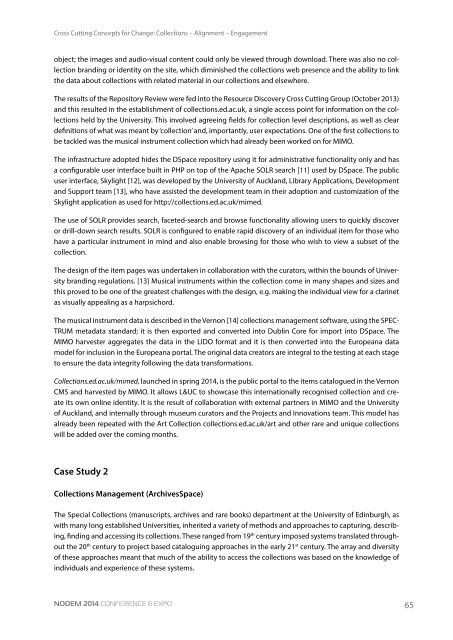NODEM 2014 Proceedings
NODEM 2014 Proceedings
NODEM 2014 Proceedings
You also want an ePaper? Increase the reach of your titles
YUMPU automatically turns print PDFs into web optimized ePapers that Google loves.
Cross Cutting Concepts for Change: Collections – Alignment – Engagement<br />
object; the images and audio-visual content could only be viewed through download. There was also no collection<br />
branding or identity on the site, which diminished the collections web presence and the ability to link<br />
the data about collections with related material in our collections and elsewhere.<br />
The results of the Repository Review were fed into the Resource Discovery Cross Cutting Group (October 2013)<br />
and this resulted in the establishment of collections.ed.ac.uk, a single access point for information on the collections<br />
held by the University. This involved agreeing fields for collection level descriptions, as well as clear<br />
definitions of what was meant by ‘collection’ and, importantly, user expectations. One of the first collections to<br />
be tackled was the musical instrument collection which had already been worked on for MIMO.<br />
The infrastructure adopted hides the DSpace repository using it for administrative functionality only and has<br />
a configurable user interface built in PHP on top of the Apache SOLR search [11] used by DSpace. The public<br />
user interface, Skylight [12], was developed by the University of Auckland, Library Applications, Development<br />
and Support team [13], who have assisted the development team in their adoption and customization of the<br />
Skylight application as used for http://collections.ed.ac.uk/mimed.<br />
The use of SOLR provides search, faceted-search and browse functionality allowing users to quickly discover<br />
or drill-down search results. SOLR is configured to enable rapid discovery of an individual item for those who<br />
have a particular instrument in mind and also enable browsing for those who wish to view a subset of the<br />
collection.<br />
The design of the item pages was undertaken in collaboration with the curators, within the bounds of University<br />
branding regulations. [13] Musical instruments within the collection come in many shapes and sizes and<br />
this proved to be one of the greatest challenges with the design, e.g. making the individual view for a clarinet<br />
as visually appealing as a harpsichord.<br />
The musical instrument data is described in the Vernon [14] collections management software, using the SPEC-<br />
TRUM metadata standard; it is then exported and converted into Dublin Core for import into DSpace. The<br />
MIMO harvester aggregates the data in the LIDO format and it is then converted into the Europeana data<br />
model for inclusion in the Europeana portal. The original data creators are integral to the testing at each stage<br />
to ensure the data integrity following the data transformations.<br />
Collections.ed.ac.uk/mimed, launched in spring <strong>2014</strong>, is the public portal to the items catalogued in the Vernon<br />
CMS and harvested by MIMO. It allows L&UC to showcase this internationally recognised collection and create<br />
its own online identity. It is the result of collaboration with external partners in MIMO and the University<br />
of Auckland, and internally through museum curators and the Projects and Innovations team. This model has<br />
already been repeated with the Art Collection collections.ed.ac.uk/art and other rare and unique collections<br />
will be added over the coming months.<br />
Case Study 2<br />
Collections Management (ArchivesSpace)<br />
The Special Collections (manuscripts, archives and rare books) department at the University of Edinburgh, as<br />
with many long established Universities, inherited a variety of methods and approaches to capturing, describing,<br />
finding and accessing its collections. These ranged from 19 th century imposed systems translated throughout<br />
the 20 th century to project based cataloguing approaches in the early 21 st century. The array and diversity<br />
of these approaches meant that much of the ability to access the collections was based on the knowledge of<br />
individuals and experience of these systems.<br />
<strong>NODEM</strong> <strong>2014</strong> Conference & Expo<br />
65


